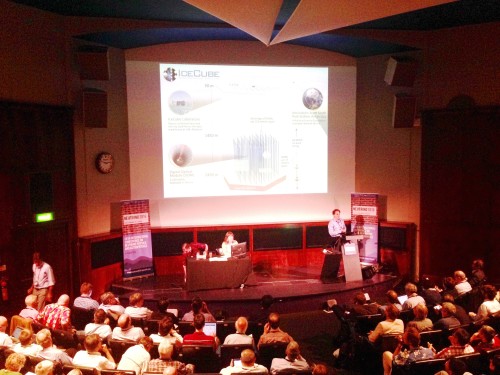
Cool operator: Marek Kowalski talking about IceCube at the Neutrino 2016 conference. (Courtesy: Tushna Commissariat)
By Tushna Commissariat at the Royal Geographical Society in London
“There are still many things to be studied in neutrinos,” said 2015 Nobel laureate Takaaki Kajita at the first talk of the Neutrino 2016 conference that began in London today. I couldn’t help but notice that his statement rang very true, as the day’s talks touched on everything from high-energy neutrinos to dark-matter searches to monitoring nuclear reactors. This year, more than 700 physicists from all over the world are attending the week-long conference, which is taking place at the historic Royal Geographical Society in London.
Today involved a fast-paced and packed schedule, with a wide range of talks that covered the standard neutrino model, neutrino astronomy and even some applications of the field. One thing in particular that caught my eye was “multimessenger astronomy” – a term used by at least three of the day’s speakers. The idea here is that as our understanding of neutrinos improves, we can truly use them to study the universe. The fact that we can now detect high-energy astrophysical neutrinos, taken together with the recent discovery of gravitational waves, truly opens a new window on our universe. Marek Kowalski and Anna Franckowiak, both part of the IceCube collaboration touched on this in their talks (see “Neutrino astronomy with IceCube and beyond” and “Multimessenger astronomy with neutrinos”, respectively), as did Imre Bartos of Columbia University in the US, who spoke about LIGO’s recent results.
An interesting example of how much the field has already progressed is the Astrophysical Multimessenger Observatory Network (AMON) programme, which involves numerous international observatories that all want to jointly analyse data from high-energy sources – such as neutrinos, photons, cosmic rays and gravitational waves – in real time. I have a feeling that “multimessenger” will be a key phrase in the astrophysics handbook in the coming years.
Do follow more updates from the conference over on our Twitter feed @PhysicsWorld or via #Neutrino2016.
Apart from the gravitational waves, where one has to heftyly gain in the detection effciency of the detectors, the most important problem about the very high energy cosmic-rays, neutrinos and gamma-rays is to reach and pin down the still-unknown source (s) of their emission and acceleration.
Trackback: Blog - physicsworld.com